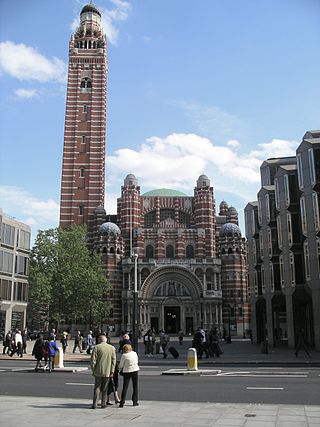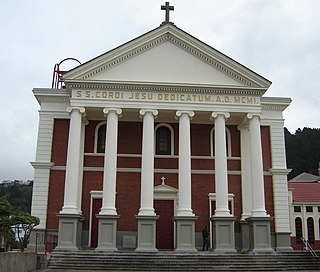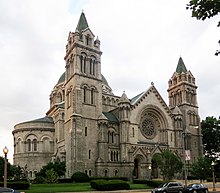
The Archdiocese of St. Louis is a Latin Church ecclesiastical territory or archdiocese of the Catholic Church that covers the City of St. Louis and the Missouri counties of Franklin, Jefferson, Lincoln, Perry, Saint Charles, Saint Francois, Ste. Genevieve, St. Louis, Warren, and Washington. It is the metropolitan see of the ecclesiastical province containing three suffragan sees: Diocese of Springfield-Cape Girardeau, the Diocese of Jefferson City, and the Diocese of Kansas City-Saint Joseph.

Westminster Cathedral is the mother church of the Catholic Church in England and Wales. It is the largest Catholic church in the UK and the seat of the Archbishop of Westminster.

St. Stephen's Basilica is a Roman Catholic basilica in Budapest, Hungary. It is named in honour of Stephen, the first King of Hungary, whose right hand is housed in the reliquary.

The Basilica of Saint Hyacinth is a historic church of the Roman Catholic Archdiocese of Chicago, located at 3636 West Wolfram Street in the Avondale neighborhood of Chicago, Illinois.

The Notre-Dame Cathedral Basilica is a Roman Catholic minor basilica in Ottawa, Ontario, Canada located on 385 Sussex Drive in the Lower Town neighbourhood. It was designated a National Historic Site of Canada in 1990.

The Basilica of Saint Mary is a Roman Catholic minor basilica located on its own city block along Hennepin Avenue between 16th and 17th Streets in downtown Minneapolis, Minnesota. It was the first basilica established in the United States. The Basilica of Saint Mary is the co-cathedral of the Roman Catholic Archdiocese of Saint Paul and Minneapolis.
The Cathedral of the Good Shepherd is the oldest Catholic church in Singapore, built in 1847. It is located in the Museum Planning Area within the Civic District.

The Primatial Basilica of the Assumption of the Blessed Virgin Mary and St Adalbert, also known as the Esztergom Basilica, is an ecclesiastic basilica in Esztergom, Hungary, the mother church of the Archdiocese of Esztergom-Budapest, and the seat of the Catholic Church in Hungary. It is dedicated to the Assumption of Saint Mary and Saint Adalbert.

The Cathedral Basilica of the Immaculate Conception is a cathedral serving Roman Catholics in the U.S. city of Mobile, Alabama. It is the seat of the Archbishop of the Roman Catholic Archdiocese of Mobile. The cathedral is named for Mary, mother of Jesus, under her title, Our Lady of the Immaculate Conception. It is listed on the National Register of Historic Places as a contributing property to the Church Street East Historic District and Lower Dauphin Street Historic District and is listed on the Historic Roman Catholic Properties in Mobile Multiple Property Submission

The Cathedral of Mary Our Queen is a Catholic cathedral located in northern Baltimore, Maryland, United States. It was completed in 1959.

The Cathedral Basilica of Saints Peter and Paul, head church of the Roman Catholic Archdiocese of Philadelphia, is located at 18th Street and the Benjamin Franklin Parkway, on the east side of Logan Square in Philadelphia. It was built between 1846 and 1864, and was designed by Napoleon LeBrun, from original plans by the Reverend Mariano Muller and the Reverend John B. Tornatore, with the dome and Palladian facade, designed by John Notman, added after 1850. The interior was largely decorated by Constantino Brumidi.

St. Mary's Basilica – officially The Church of the Immaculate Conception of the Blessed Virgin Mary – is a church of the Diocese of Phoenix located at 231 North 3rd Street at the corner of East Monroe Street in downtown Phoenix, Arizona. It was previously known as St. Mary's Church. It was built from 1902 to 1914 in a combination of the Mission Revival and Spanish Colonial Revival styles, and was dedicated in 1915. It replaced an earlier adobe church built in 1881 when the parish was founded. From 1895 the parish was staffed by the Franciscan Friars, but it is currently staffed and operated by clergy of the Diocese of Phoenix. The current church was elevated to a minor basilica by Pope John Paul II in 1985.

The Co-Cathedral of the Sacred Heart is a place of worship located at 1111 St. Joseph Parkway in downtown Houston. The co-cathedral seats 1,820 people in its 32,000-square-foot (3,000 m2) sanctuary. Together with the venerable St. Mary's Cathedral Basilica in Galveston, Sacred Heart serves more than 1.2 million Roman Catholics in the Archdiocese of Galveston-Houston.

The Cathedral Basilica of Christ the King is a Roman Catholic church in Hamilton, Ontario, Canada. The cathedral was consecrated on December 19, 1933. It is the seat of the bishop of the Diocese of Hamilton, and the cathedral of the Diocese of Hamilton. The cathedral contains the cathedra of the bishop, the Most Rev. Douglas Crosby. The cathedral was raised to the status of a minor basilica in February 2013 by Pope Benedict XVI.

The Metropolitan Cathedral of the Sacred Heart and of Saint Mary His Mother, better known as Sacred Heart Cathedral, is a Roman Catholic cathedral on Hill Street, Wellington, New Zealand. It is the parish church of the Thorndon Catholic parish and the cathedral of the Archbishop of Wellington. The New Zealand Parliament is a close neighbour of the cathedral. However, the Thorndon Catholic parish predates that institution. The cathedral is part of a Catholic precinct which includes: St Mary's College; Sacred Heart Cathedral School; St Mary's Convent, the motherhouse of the Sisters of Mercy in Wellington; the Catholic Centre, in which Catholic administration is located; and Viard House, which is both the cathedral parish presbytery and the residence of the archbishop.

St. Francis de Sales Church is a Roman Catholic Oratory located in south St. Louis, Missouri, United States. It is the second largest church in the Archdiocese of St. Louis after the cathedral-basilica. The church is popularly known as the "Cathedral of South St. Louis".

Holy Name Church in West Roxbury is a Roman Catholic church of the Archdiocese of Boston.

The Roman Catholic St. Mary's Cathedral Basilica of the Assumption in Covington, Kentucky, is a minor basilica in the United States. Construction of the cathedral began under the Diocese of Covington's third bishop, Camillus Paul Maes, in 1895 to replace an 1834 frame church that was inadequate for the growing congregation. Pope Pius XII elevated the cathedral to the rank of minor basilica on December 8, 1953.

Saints Peter and Paul Cathedral is a Roman Catholic cathedral located at Fourteenth and Meridian Streets in Indianapolis, Indiana, United States. It is the seat of the Archdiocese of Indianapolis, and of the Archbishop of Indianapolis, most recently Archbishop Charles C. Thompson. Silas Chatard, the first Bishop of Indianapolis, established the cathedral parish in 1892, and named it after Saint Peter and Saint Paul, two apostles of Christ. The cathedral parish became known for its liturgical celebrations and sacred music performances.

The Sacred Heart Basilica or Timaru Basilica, is a Catholic church in Timaru, New Zealand. Despite its name, it is not legally designated as a basilica by the Catholic Church. It was designed by the New Zealand architect, Francis Petre and is one of his most celebrated works. Its size and appearance make it one of the most important historic buildings of Timaru and of the South Canterbury region. The Basilica's twin towers and copper cupola are highly visible features of the Timaru skyline, especially from the south. The Basilica is also one of the "most noteworthy examples of ecclesiastical architecture" in New Zealand with elements of "Roman and Byzantine architecture with touches of Art Nouveau decoration." It is a registered historic place, category 1.






































